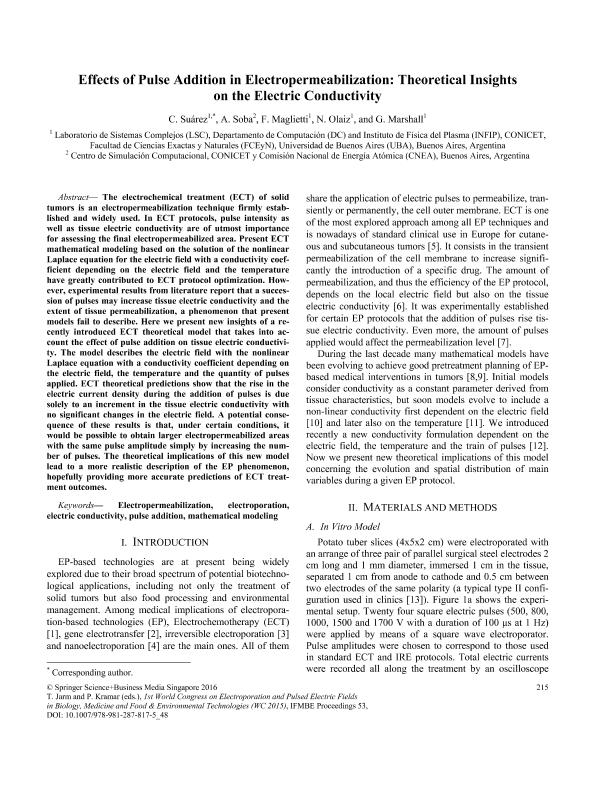Artículo
Effects of pulse addition in electropermeabilization: Theoretical insights on the electric conductivity
Suárez, Cecilia Ana ; Soba, Alejandro
; Soba, Alejandro ; Maglietti, Felipe Horacio
; Maglietti, Felipe Horacio ; Olaiz, Nahuel Manuel
; Olaiz, Nahuel Manuel ; Marshall, Guillermo Ricardo
; Marshall, Guillermo Ricardo
 ; Soba, Alejandro
; Soba, Alejandro ; Maglietti, Felipe Horacio
; Maglietti, Felipe Horacio ; Olaiz, Nahuel Manuel
; Olaiz, Nahuel Manuel ; Marshall, Guillermo Ricardo
; Marshall, Guillermo Ricardo
Fecha de publicación:
11/2016
Editorial:
Springer
Revista:
Ifmbe Proceedings
ISSN:
1680-0737
Idioma:
Inglés
Tipo de recurso:
Artículo publicado
Clasificación temática:
Resumen
The electrochemical treatment (ECT) of solid tumors is an electropermeabilization technique firmly established and widely used. In ECT protocols, pulse intensity as well as tissue electric conductivity are of utmost importance for assessing the final electropermeabilized area. Present ECT mathematical modeling based on the solution of the nonlinear Laplace equation for the electric field with a conductivity coefficient depending on the electric field and the temperature have greatly contributed to ECT protocol optimization. However, experimental results from literature report that a succession of pulses may increase tissue electric conductivity and the extent of tissue permeabilization, a phenomenon that present models fail to describe. Here we present new insights of a recently introduced ECT theoretical model that takes into account the effect of pulse addition on tissue electric conductivity. The model describes the electric field with the nonlinear Laplace equation with a conductivity coefficient depending on the electric field, the temperature and the quantity of pulses applied. ECT theoretical predictions show that the rise in the electric current density during the addition of pulses is due solely to an increment in the tissue electric conductivity with no significant changes in the electric field. A potential consequence of these results is that, under certain conditions, it would be possible to obtain larger electropermeabilized areas with the same pulse amplitude simply by increasing the number of pulses. The theoretical implications of this new model lead to a more realistic description of the EP phenomenon, hopefully providing more accurate predictions of ECT treatment outcomes.
Archivos asociados
Licencia
Identificadores
Colecciones
Articulos(INFINA)
Articulos de INST.DE FISICA DEL PLASMA
Articulos de INST.DE FISICA DEL PLASMA
Citación
Suárez, Cecilia Ana; Soba, Alejandro; Maglietti, Felipe Horacio; Olaiz, Nahuel Manuel; Marshall, Guillermo Ricardo; Effects of pulse addition in electropermeabilization: Theoretical insights on the electric conductivity; Springer; Ifmbe Proceedings; 53; 11-2016; 215-218
Compartir
Altmétricas



